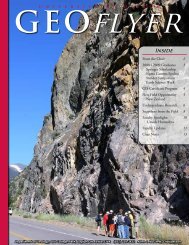Stander Symposium abstract book - University of Dayton
Stander Symposium abstract book - University of Dayton
Stander Symposium abstract book - University of Dayton
You also want an ePaper? Increase the reach of your titles
YUMPU automatically turns print PDFs into web optimized ePapers that Google loves.
ORAL PRESENTATIONS<br />
The Classical Influence: The Design <strong>of</strong> American <strong>University</strong> Campuses, the <strong>University</strong> <strong>of</strong><br />
<strong>Dayton</strong>, and the Ideals <strong>of</strong> American Society<br />
Presenter(s): Caroline M Ibbotson<br />
Advisor(s): Roger J Crum<br />
Visual Arts<br />
2:00 PM-2:20 PM<br />
Independent Research Kennedy Union - 222<br />
Since the founding <strong>of</strong> the United States, institutions both civic and academic have looked to the Greeks and the Romans as models for life and<br />
learning. American universities not only drew upon these ancient civilizations for curriculumâtrivium and quadriviumâbut also drew inspiration<br />
from their architecture. The <strong>University</strong> <strong>of</strong> Virginiaâs campus, designed by Thomas Jefferson, is a prime example <strong>of</strong> the use <strong>of</strong> classical design for a<br />
college campus both in terms <strong>of</strong> layout and architectural planning. In the 1920s, the <strong>University</strong> <strong>of</strong> <strong>Dayton</strong> too aspired to possess a campus designed<br />
according to this tradition in a new master plan. That ambitious, and now largely forgotten master plan, was far from realized; indeed, only one<br />
building from the design was constructed. While numerous reasons may account for how partially the university realized its classical plan, other<br />
universities at that time similarly began to depart from both the classical model <strong>of</strong> education and campus design. The reasons for classical inspiration<br />
on American campuses, and the birth, demise, and occasional rebirth <strong>of</strong> classical models at the <strong>University</strong> <strong>of</strong> <strong>Dayton</strong> are examined by this<br />
presentation as a way <strong>of</strong> interpreting the changing meaning <strong>of</strong> <strong>Dayton</strong>’s campus over time.<br />
Visual Identity: A Problem-solving Approach to Identity Design<br />
Presenter(s): Gerard A Gerace, Hannah M Magnan, Kelly E Morris<br />
Advisor(s): Jayne M Whitaker<br />
Visual Arts<br />
Senior/Capstone Project<br />
2:00 PM-3:00 PM<br />
ArtStreet - Studio E<br />
A visual identity is the personality <strong>of</strong> a company, institution, small group or organization and is designed to meet specific business objectives. It<br />
is most <strong>of</strong>ten manifested by way <strong>of</strong> branding and the use <strong>of</strong> trademarks and comes into being when there is a common ownership <strong>of</strong> an organizational<br />
philosophy. Students in the senior level Graphic Design III course were required to research, design or redesign, and present a trademark<br />
for an existing museum collection or museum. Building upon their mark <strong>of</strong> identity, students then created a new innovative visual identity for<br />
their fictitious client with elements ranging from stationery, business papers, and various two-dimensional print and electronic media to threedimensional<br />
display and or packaging collateral. The visual identity systems reflect a hypothetical but real world approach to product, service, and<br />
promotion with specific intentions <strong>of</strong> broadening awareness <strong>of</strong> the museum as well as the scope <strong>of</strong> its potential audience. Each <strong>of</strong> the projects<br />
presented reflect a student’s own developmental undergraduate research in the design <strong>of</strong> the museum collection, its name, marketing position<br />
and growth potential. The projects presented are selected samples <strong>of</strong> the extensive written and visual development that contributed to each <strong>of</strong><br />
the visual identity design systems with additional design systems on display in the Department <strong>of</strong> Visual Arts during the closing reception <strong>of</strong> the<br />
annual juried Horvath exhibition in College Park Center.<br />
Fin<br />
Presenter(s): Luke A Effler, Sarah N Fortener, Erin E Gottron, Brandon M Lowery, Sean E Montgomery,<br />
Rebecca L Roman<br />
Advisor(s): Michael G Marcinowski<br />
Visual Arts<br />
2:40 PM-3:40 PM<br />
Senior/Capstone Project<br />
ArtStreet - Studio C<br />
The <strong>Stander</strong> <strong>Symposium</strong> presentation is the final part <strong>of</strong> the capstone course required for all Fine Art majors. This capstone looks to help define the<br />
formal elements within the student’s artwork as well as a personal and stylistic approach. This course functions as a way to help students develop<br />
a cohesive pr<strong>of</strong>essional portfolio. The course also acts as a vehicle to prepare students for real world interaction. The students will present their<br />
portfolio in a pr<strong>of</strong>essional format on the day <strong>of</strong> <strong>Stander</strong> <strong>Symposium</strong> as a culmination <strong>of</strong> the capstone course.<br />
131

















